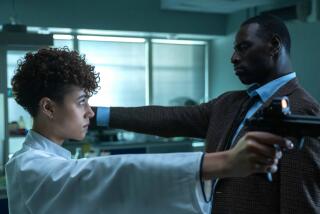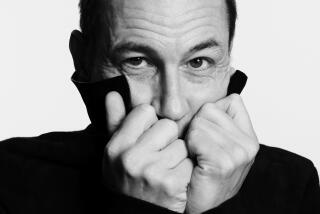Just call him ‘The Punisher’
- Share via
Though he has broken his neck three times and had multiple knee surgeries over the years, Gary Hymes knew that an unconscious lead actor would be a problem of a different magnitude.
Hymes, second unit director and stunt coordinator for an action film called “The Punisher,” was shooting an elaborate fight scene that required Thomas Jane, as the Punisher, to fling himself through a breakaway wall. The wall gave way as planned, but Jane’s momentum sent him sailing onward into a reinforced retaining wall, which the actor hit with his head, landing in a heap on the floor. Once director Jonathan Hensleigh had yelled “cut,” Hymes rushed to Jane’s side. The actor was a little shaken but OK.
“Watching Thomas on the floor, I was thinking, ‘Please let this be acting,’ ” recalls Hymes. “If he should get hurt, it shuts down the film, and I’m the one that’s responsible. Plus, I care about these people and don’t want to see anyone hurt.”
Plenty of people are to get hurt on screen in “The Punisher,” however, and that’s where the art of illusion steps in. Based on the long-running Marvel comic-book character with the distinctive skull-faced T-shirt, the film is, in the parlance of the realm, an “origin story.” Jane’s character, Frank Castle, is an elite federal agent whose entire family is wiped out by a vengeful criminal kingpin.
Pushed to the edge, he pushes back. Hard.
Hymes estimates that Jane did about 75% of his own stunts. The last star Hymes can remember doing so much of his own stunt work was Keanu Reeves, for “Speed,” and Hymes would know. A veteran stunt coordinator with credits stretching from Brian De Palma’s “The Untouchables” (it was his infant son in that film’s famed baby-carriage sequence) to the recent remake of “The Italian Job,” Hymes has been involved in many memorable stunt sequences over the years. And “The Punisher,” a Lions Gate film that opens Friday, is likely to add a few more to that list.
With a relatively small budget of $34 million (of which a sizable chunk went to securing John Travolta as the film’s villain) and a 52-day schedule that was remarkably brisk for an action picture, “The Punisher” offered considerable challenges. The biggest one: how to create compelling action sequences and special effects when you don’t have the time and money for computers and re-shooting.
Director’s change of pace
For Hensleigh, a first-time director known for his involvement as writer (both credited and uncredited) and/or executive producer on such big-ticket films as “The Rock,” “Armageddon” and “Gone in Sixty Seconds,” an adaptation of the long-running “The Punisher” comic-book series was an opportunity to make a gritty, violent action picture that would be a far cry from the high-gloss movies he had previously been involved in. Moreover, it would give him a chance to make an uncompromising exploration of manly adventure in the vein of such films as “Bullitt,” and “The French Connection” and filmmakers such as Sam Peckinpah, Sergio Leone and Don Siegel.
He specifically wanted to stage as much of the action as possible for real -- for financial as well as aesthetic reasons.”If you break it down,” reports Hensleigh, “the cost difference of a good effects man against ordering shots from an effects house, it’s much cheaper to do it practically, and it looks 10 times better. It was a no-brainer as far as I was concerned.” As to Hollywood’s current predilection toward computer-generated imagery, Hensleigh adds, “It’s a mystery to me.”
Hymes, pointing to action sequences, and specifically the computer-enhanced car chases, in such recent films as “Bad Boys 2,” “Terminator 3: Rise of the Machines” and the “Matrix” pictures, was particularly energized by Hensleigh’s enthusiasm for real stunt work.
“This old-school notion, I was on board as soon as he said that,” Hymes says. “That was one of the things that excited me, knowing we have to be clever about it. We couldn’t just bail ourselves out later with CGI. Here, the story and the characters and the actors were meant to get you from A to B without any embellishment.”
As for the limits of the film’s relatively modest budget, Hymes admits he called in a number of favors attempting to achieve “the $60-million look for less than half that.” It was important to make the most of what they had, he says, adding, “The day I went in to meet with everybody I said I would rather do six major gags the best they can be done, throw everything we have into them, than to do 12 things that are mediocre.”
A four-day battle
Thomas JANE’S bone-thumping wall collision came during the four days dedicated to shooting the Punisher’s confrontation with a gigantic assassin known simply as the Russian. Truly a knock-down, drag-out fight, the sequence, among the most memorable in the film, has its origins in a few panels of “Welcome Back, Frank,” a Punisher comic written by Garth Ennis. Hensleigh, who particularly liked Ennis’ modulation of “the brutally violent and a loopy, slapstick quality,” story-boarded the sequence very early on, so that “I could design the fight, and fit the space to the fight.”
The biggest challenge came in actually casting the role with someone who could sufficiently dwarf Jane. Hensleigh wanted to shoot Jane and the actor playing the Russian head to toe in a wide shot. “Very few fights feature that kind of photography,” he says. “Contemporary fight shooting usually gets right into the hands and the torsos, with all this fast editing. I wanted some sense of that, but I wanted that to be interspersed with big wide shots so you see it’s actually Thomas Jane and actually the actor playing the Russian.”
Professional wrestler Kevin Nash eventually filled the role. Not only did his 6-foot-10, 307-pound frame provide the desired visual contrast to Jane’s 5-foot-10, 170-pound physique, but Nash’s wrestling background meant he was well versed in fight choreography. Nash required a stunt double only for a fall down a stairwell that was done on a separately built piece of the set.
For Hymes, a former champion motorcycle and auto racer, there were plenty of car stunts as well. A scene in which a car jumps over a bridge came about only after another location fell through due to problems obtaining the necessary permits. He notes with pride that he predicted within two feet where the car jumping the bridge would land (just as he did when jumping a bus in “Speed”).
Despite all of his meticulous preparations and cautious calculations, though, Hymes admits that the outcome of individual stunts can often be hard to foresee. There are times when he simply hopes for the best while preparing for the worst, relying on what he calls “PGW,” short for “precision guesswork.”
Case in point: the stunt in which two pickup trucks, a trailer and a small fishing boat all slap together in an over-the-top collision. Hymes, belying the mix of skill, planning and happenstance that is the stuntman’s lot, admits he wasn’t particularly sure what was really going to happen.
Bottom line, though, he says, “I knew there was going to be a big wreck.”
More to Read
Only good movies
Get the Indie Focus newsletter, Mark Olsen's weekly guide to the world of cinema.
You may occasionally receive promotional content from the Los Angeles Times.










